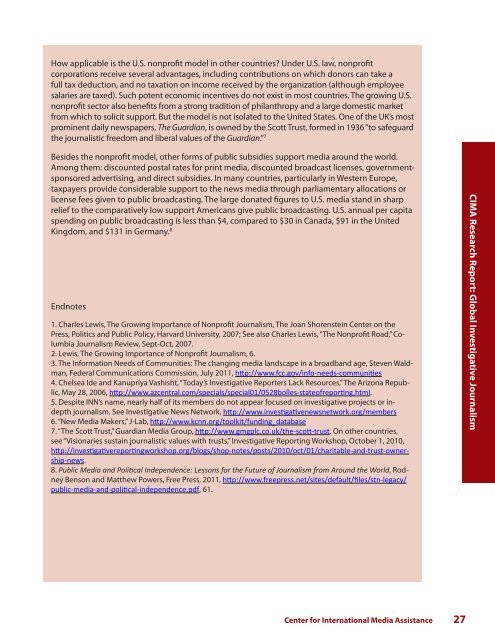CIMA-Investigative Journalism - Dave Kaplan
CIMA-Investigative Journalism - Dave Kaplan
CIMA-Investigative Journalism - Dave Kaplan
Create successful ePaper yourself
Turn your PDF publications into a flip-book with our unique Google optimized e-Paper software.
How applicable is the U.S. nonprofit model in other countries? Under U.S. law, nonprofit<br />
corporations receive several advantages, including contributions on which donors can take a<br />
full tax deduction, and no taxation on income received by the organization (although employee<br />
salaries are taxed). Such potent economic incentives do not exist in most countries. The growing U.S.<br />
nonprofit sector also benefits from a strong tradition of philanthropy and a large domestic market<br />
from which to solicit support. But the model is not isolated to the United States. One of the UK’s most<br />
prominent daily newspapers, The Guardian, is owned by the Scott Trust, formed in 1936 “to safeguard<br />
the journalistic freedom and liberal values of the Guardian.” 7<br />
Besides the nonprofit model, other forms of public subsidies support media around the world.<br />
Among them: discounted postal rates for print media, discounted broadcast licenses, governmentsponsored<br />
advertising, and direct subsidies. In many countries, particularly in Western Europe,<br />
taxpayers provide considerable support to the news media through parliamentary allocations or<br />
license fees given to public broadcasting. The large donated figures to U.S. media stand in sharp<br />
relief to the comparatively low support Americans give public broadcasting. U.S. annual per capita<br />
spending on public broadcasting is less than $4, compared to $30 in Canada, $91 in the United<br />
Kingdom, and $131 in Germany. 8<br />
Endnotes<br />
1. Charles Lewis, The Growing Importance of Nonprofit <strong>Journalism</strong>, The Joan Shorenstein Center on the<br />
Press, Politics and Public Policy, Harvard University, 2007; See also Charles Lewis, “The Nonprofit Road,” Columbia<br />
<strong>Journalism</strong> Review, Sept-Oct, 2007.<br />
2. Lewis, The Growing Importance of Nonprofit <strong>Journalism</strong>, 6.<br />
3. The Information Needs of Communities: The changing media landscape in a broadband age, Steven Waldman,<br />
Federal Communications Commission, July 2011, http://www.fcc.gov/info-needs-communities<br />
4. Chelsea Ide and Kanupriya Vashisht, “Today’s <strong>Investigative</strong> Reporters Lack Resources,” The Arizona Republic,<br />
May 28, 2006, http://www.azcentral.com/specials/special01/0528bolles-stateofreporting.html.<br />
5. Despite INN’s name, nearly half of its members do not appear focused on investigative projects or indepth<br />
journalism. See <strong>Investigative</strong> News Network, http://www.investigativenewsnetwork.org/members<br />
6. “New Media Makers,” J-Lab, http://www.kcnn.org/toolkit/funding_database<br />
7. “The Scott Trust,” Guardian Media Group, http://www.gmgplc.co.uk/the-scott-trust. On other countries,<br />
see “Visionaries sustain journalistic values with trusts,” <strong>Investigative</strong> Reporting Workshop, October 1, 2010,<br />
http://investigativereportingworkshop.org/blogs/shop-notes/posts/2010/oct/01/charitable-and-trust-ownership-news.<br />
8. Public Media and Political Independence: Lessons for the Future of <strong>Journalism</strong> from Around the World, Rodney<br />
Benson and Matthew Powers, Free Press, 2011, http://www.freepress.net/sites/default/files/stn-legacy/<br />
public-media-and-political-independence.pdf, 61.<br />
Center for International Media Assistance 27<br />
<strong>CIMA</strong> Research Report: Global <strong>Investigative</strong> <strong>Journalism</strong>


